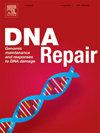Joining of DNA breaks- interplay between DNA ligases and poly (ADP-ribose) polymerases
IF 2.7
3区 生物学
Q2 GENETICS & HEREDITY
引用次数: 0
Abstract
The joining of DNA single- and double-strand breaks (SSB and DSB) is essential for maintaining genome stability and integrity. While this is ultimately accomplished in human cells by the DNA ligases encoded by the LIG1, LIG3 and LIG4 genes, these enzymes are recruited to DNA breaks through specific interactions with proteins involved in break sensing and recognition and/or break processing. In this review, we focus on the interplay between the DNA break-activated poly (ADP-ribose) polymerases, PARP1 and PARP2, poly (ADP-ribose) (PAR) and the DNA ligases in DNA replication and repair. The most extensively studied example of this interplay is the recruitment of DNA ligase IIIα (LigIIIα) and other repair proteins to SSBs through an interaction between XRCC1, a scaffold protein and partner protein of nuclear LigIIIα, and PAR synthesized by PARP1 and to a lesser extent PARP2. Recently, these proteins have been implicated in a back-up pathway for joining Okazaki fragments that appears to have a critical function even in cells with no defect in the major LigI-dependent pathway. Finally, we discuss the effects of FDA-approved PARP1/2 inhibitors on DNA replication and repair in cancer and non-malignant cells and the potential utility of DNA ligase inhibitors as cancer therapeutics.
DNA断裂的连接- DNA连接酶和多聚核糖聚合酶之间的相互作用
DNA单链和双链断裂(SSB和DSB)的连接对于维持基因组的稳定性和完整性至关重要。虽然这最终是通过由LIG1、LIG3和LIG4基因编码的DNA连接酶在人类细胞中完成的,但这些酶通过与断裂感知、识别和/或断裂加工中涉及的蛋白质的特定相互作用被招募到DNA断裂中。本文综述了DNA断裂激活聚(adp -核糖)聚合酶PARP1和PARP2、聚(adp -核糖)(PAR)与DNA连接酶在DNA复制和修复中的相互作用。这种相互作用的最广泛研究的例子是DNA连接酶IIIα (LigIIIα)和其他修复蛋白通过XRCC1(核LigIIIα的支架蛋白和伴侣蛋白)与PARP1合成的PAR (PARP2合成的PAR)相互作用募集到SSBs。最近,这些蛋白参与了连接Okazaki片段的备用途径,即使在主要依赖ligi的途径中没有缺陷的细胞中也具有关键功能。最后,我们讨论了fda批准的PARP1/2抑制剂对癌症和非恶性细胞中DNA复制和修复的影响,以及DNA连接酶抑制剂作为癌症治疗药物的潜在用途。
本文章由计算机程序翻译,如有差异,请以英文原文为准。
求助全文
约1分钟内获得全文
求助全文
来源期刊

DNA Repair
生物-毒理学
CiteScore
7.60
自引率
5.30%
发文量
91
审稿时长
59 days
期刊介绍:
DNA Repair provides a forum for the comprehensive coverage of DNA repair and cellular responses to DNA damage. The journal publishes original observations on genetic, cellular, biochemical, structural and molecular aspects of DNA repair, mutagenesis, cell cycle regulation, apoptosis and other biological responses in cells exposed to genomic insult, as well as their relationship to human disease.
DNA Repair publishes full-length research articles, brief reports on research, and reviews. The journal welcomes articles describing databases, methods and new technologies supporting research on DNA repair and responses to DNA damage. Letters to the Editor, hot topics and classics in DNA repair, historical reflections, book reviews and meeting reports also will be considered for publication.
 求助内容:
求助内容: 应助结果提醒方式:
应助结果提醒方式:


